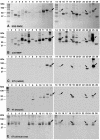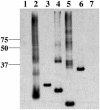Expression and immunogenicity of proteins encoded by sequences specific to Mycobacterium avium subsp. paratuberculosis
- PMID: 14715739
- PMCID: PMC321684
- DOI: 10.1128/JCM.42.1.106-114.2004
Expression and immunogenicity of proteins encoded by sequences specific to Mycobacterium avium subsp. paratuberculosis
Abstract
The development of immunoassays specific for the diagnosis of Johne's disease in cattle requires antigens specific to Mycobacterium avium subsp. paratuberculosis. However, because of genetic similarity to other mycobacteria comprising the M. avium complex, no such antigens have been found. Through a comparative genomics approach, 21 potential coding sequences of M. avium subsp. paratuberculosis that are not represented in any other mycobacterial species tested (n = 9) were previously identified (J. P. Bannantine, E. Baechler, Q. Zhang, L. Li, and V. Kapur, J. Clin. Microbiol. 40:1303-1310, 2002). Here we describe the cloning, heterologous expression, and antigenic analysis of these M. avium subsp. paratuberculosis-specific sequences in Escherichia coli. Nucleotide sequences representing each unique predicted coding region were amplified and cloned into two different E. coli expression vectors encoding polyhistidine or maltose binding protein (MBP) affinity purification tags. All 21 of the MBP fusion proteins were successfully purified under denaturing conditions and were evaluated in immunoblotting studies with sera from rabbits and mice immunized with M. avium subsp. paratuberculosis. These studies showed that 5 of the 21 gene products are produced by M. avium subsp. paratuberculosis and are antigenic. Immunoblot analysis with a panel of sera from 9 healthy cattle and 10 cattle with clinical disease shows that the same five M. avium subsp. paratuberculosis proteins are also detected within the context of infection. Collectively, these studies have used a genomic approach to identify novel M. avium subsp. paratuberculosis antigens that are not present in any other mycobacteria. These findings may have a major impact on improved diagnostics for Johne's disease.
Figures


References
-
- Ausubel, F. M., R. Brent, R. E. Kingston, D. D. Moore, J. G. Seidman, J. A. Smith, and K. Struhl. 1987. Current protocols in molecular biology. Greene Publishing Associates and Wiley-Interscience, New York, N.Y.
-
- Bannantine, J. P., and J. R. Stabel. 2001. Identification of two Mycobacterium avium subspecies paratuberculosis gene products differentially recognised by sera from rabbits immunised with live mycobacteria but not heat-killed mycobacteria. J. Med. Microbiol. 50:795-804. - PubMed
Publication types
MeSH terms
Substances
LinkOut - more resources
Full Text Sources
Other Literature Sources
Miscellaneous

